Business Law Assignment: Contract and Employment Law Issues Analysis
VerifiedAdded on 2022/09/22
|9
|1745
|24
Homework Assignment
AI Summary
This Business Law assignment solution addresses two key legal issues: contract formation in a business context and employment law disputes within a family business. The first question analyzes the communications between Footloose Pty Ltd, Famous Footwear, and James's Shoes, determining whether a legally binding contract was formed. It examines the concepts of an invitation to treat, offer, counter-offer, and acceptance, referencing relevant case law such as Fisher v Bell and Hyde v Wrench. The second question focuses on an employment dispute where Lily was terminated from her family's real estate business and denied her wages. It explores the application of employment law principles, emphasizing the illegality of termination based on personal arguments and the obligation to pay earned wages, even within a family business. The solution provides a detailed analysis of the facts, legal rules, and application, leading to clear conclusions on the legal outcomes of each scenario, and includes a list of cited references.

Running head: BUSINESS LAW
Business Law
Name of the Student
Name of the University
Author Note
Business Law
Name of the Student
Name of the University
Author Note
Paraphrase This Document
Need a fresh take? Get an instant paraphrase of this document with our AI Paraphraser

1BUSINESS LAW
Table of Contents
Question 1..................................................................................................................................2
Question 2..................................................................................................................................6
References..................................................................................................................................8
Table of Contents
Question 1..................................................................................................................................2
Question 2..................................................................................................................................6
References..................................................................................................................................8
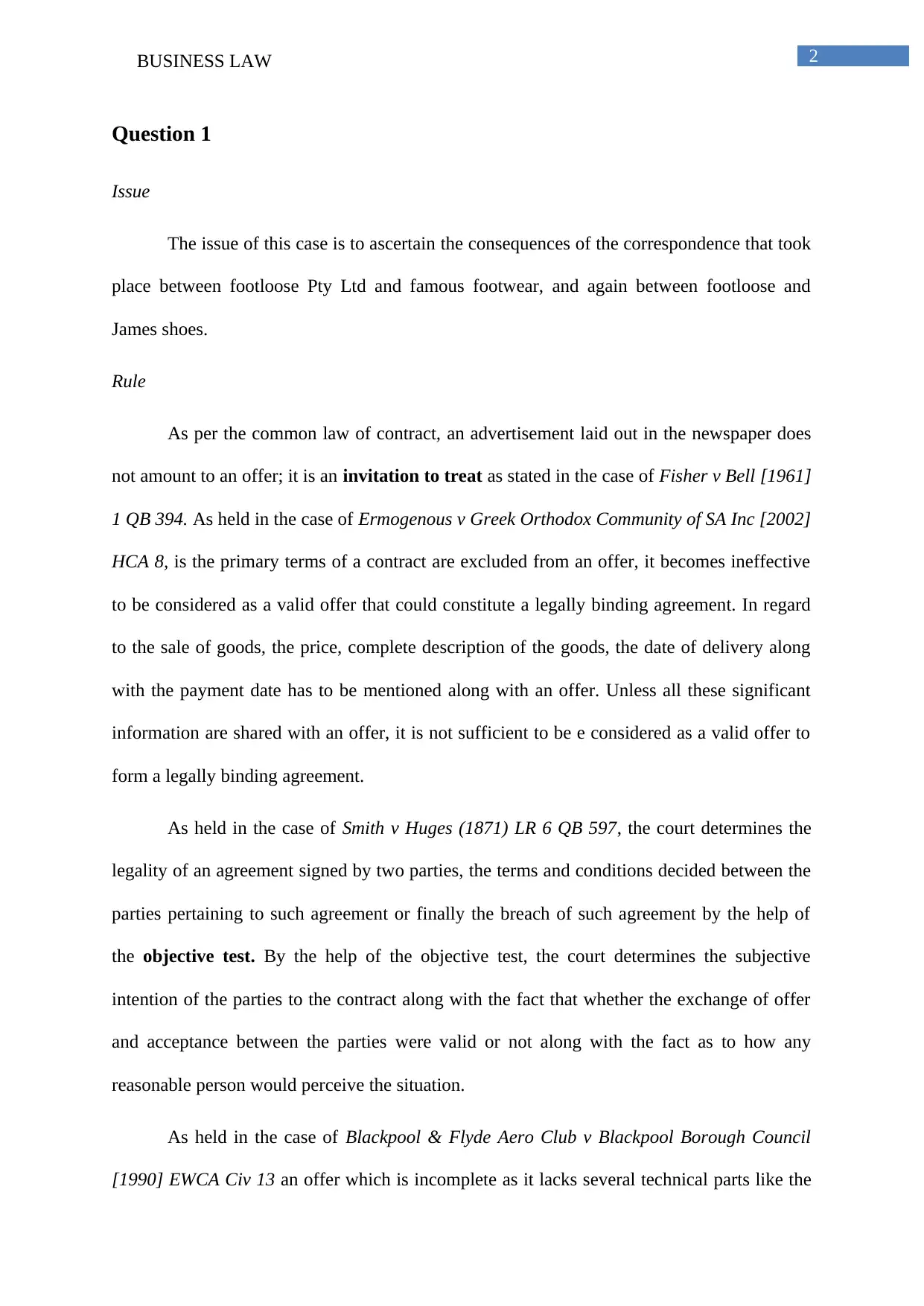
2BUSINESS LAW
Question 1
Issue
The issue of this case is to ascertain the consequences of the correspondence that took
place between footloose Pty Ltd and famous footwear, and again between footloose and
James shoes.
Rule
As per the common law of contract, an advertisement laid out in the newspaper does
not amount to an offer; it is an invitation to treat as stated in the case of Fisher v Bell [1961]
1 QB 394. As held in the case of Ermogenous v Greek Orthodox Community of SA Inc [2002]
HCA 8, is the primary terms of a contract are excluded from an offer, it becomes ineffective
to be considered as a valid offer that could constitute a legally binding agreement. In regard
to the sale of goods, the price, complete description of the goods, the date of delivery along
with the payment date has to be mentioned along with an offer. Unless all these significant
information are shared with an offer, it is not sufficient to be e considered as a valid offer to
form a legally binding agreement.
As held in the case of Smith v Huges (1871) LR 6 QB 597, the court determines the
legality of an agreement signed by two parties, the terms and conditions decided between the
parties pertaining to such agreement or finally the breach of such agreement by the help of
the objective test. By the help of the objective test, the court determines the subjective
intention of the parties to the contract along with the fact that whether the exchange of offer
and acceptance between the parties were valid or not along with the fact as to how any
reasonable person would perceive the situation.
As held in the case of Blackpool & Flyde Aero Club v Blackpool Borough Council
[1990] EWCA Civ 13 an offer which is incomplete as it lacks several technical parts like the
Question 1
Issue
The issue of this case is to ascertain the consequences of the correspondence that took
place between footloose Pty Ltd and famous footwear, and again between footloose and
James shoes.
Rule
As per the common law of contract, an advertisement laid out in the newspaper does
not amount to an offer; it is an invitation to treat as stated in the case of Fisher v Bell [1961]
1 QB 394. As held in the case of Ermogenous v Greek Orthodox Community of SA Inc [2002]
HCA 8, is the primary terms of a contract are excluded from an offer, it becomes ineffective
to be considered as a valid offer that could constitute a legally binding agreement. In regard
to the sale of goods, the price, complete description of the goods, the date of delivery along
with the payment date has to be mentioned along with an offer. Unless all these significant
information are shared with an offer, it is not sufficient to be e considered as a valid offer to
form a legally binding agreement.
As held in the case of Smith v Huges (1871) LR 6 QB 597, the court determines the
legality of an agreement signed by two parties, the terms and conditions decided between the
parties pertaining to such agreement or finally the breach of such agreement by the help of
the objective test. By the help of the objective test, the court determines the subjective
intention of the parties to the contract along with the fact that whether the exchange of offer
and acceptance between the parties were valid or not along with the fact as to how any
reasonable person would perceive the situation.
As held in the case of Blackpool & Flyde Aero Club v Blackpool Borough Council
[1990] EWCA Civ 13 an offer which is incomplete as it lacks several technical parts like the
⊘ This is a preview!⊘
Do you want full access?
Subscribe today to unlock all pages.

Trusted by 1+ million students worldwide
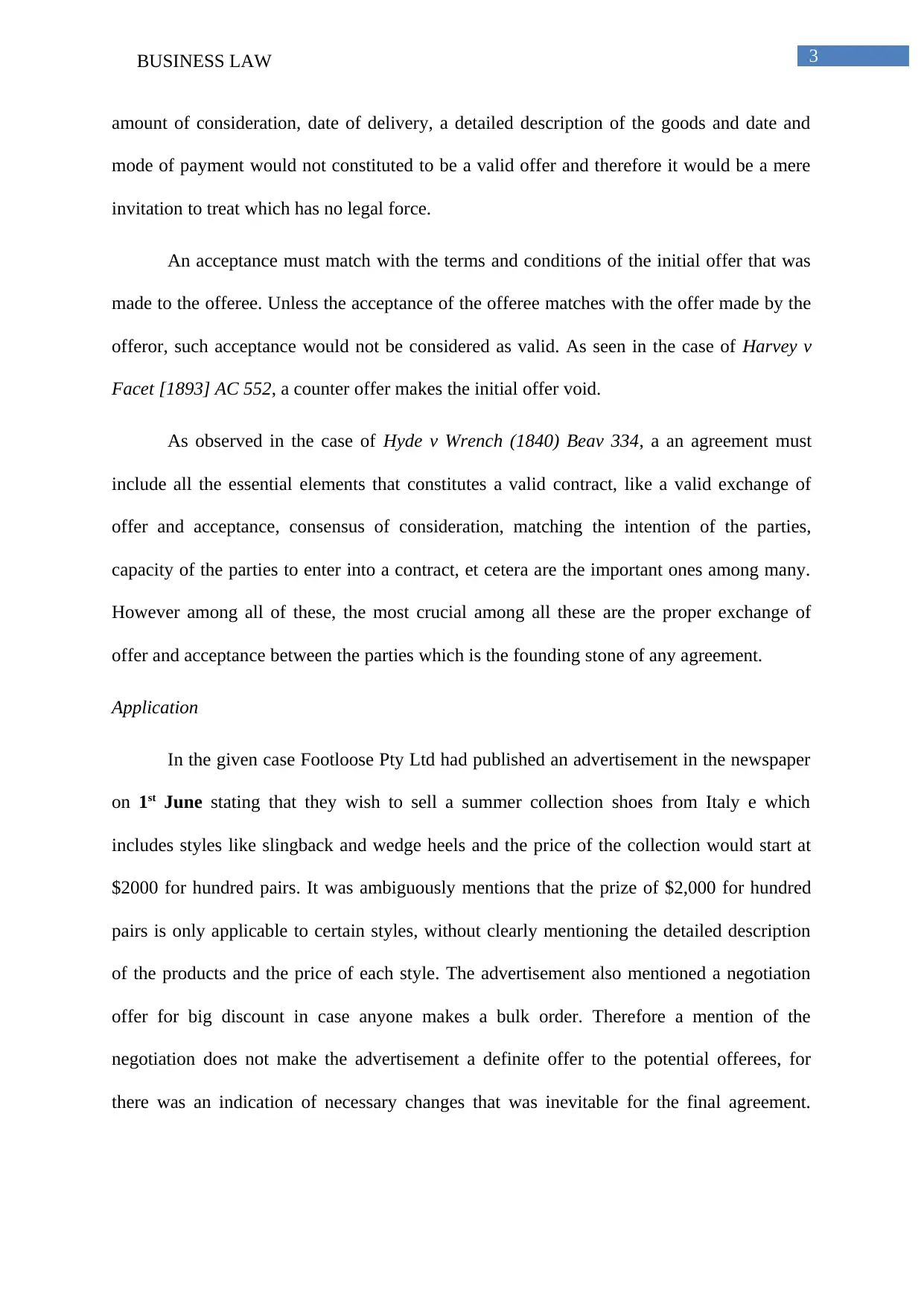
3BUSINESS LAW
amount of consideration, date of delivery, a detailed description of the goods and date and
mode of payment would not constituted to be a valid offer and therefore it would be a mere
invitation to treat which has no legal force.
An acceptance must match with the terms and conditions of the initial offer that was
made to the offeree. Unless the acceptance of the offeree matches with the offer made by the
offeror, such acceptance would not be considered as valid. As seen in the case of Harvey v
Facet [1893] AC 552, a counter offer makes the initial offer void.
As observed in the case of Hyde v Wrench (1840) Beav 334, a an agreement must
include all the essential elements that constitutes a valid contract, like a valid exchange of
offer and acceptance, consensus of consideration, matching the intention of the parties,
capacity of the parties to enter into a contract, et cetera are the important ones among many.
However among all of these, the most crucial among all these are the proper exchange of
offer and acceptance between the parties which is the founding stone of any agreement.
Application
In the given case Footloose Pty Ltd had published an advertisement in the newspaper
on 1st June stating that they wish to sell a summer collection shoes from Italy e which
includes styles like slingback and wedge heels and the price of the collection would start at
$2000 for hundred pairs. It was ambiguously mentions that the prize of $2,000 for hundred
pairs is only applicable to certain styles, without clearly mentioning the detailed description
of the products and the price of each style. The advertisement also mentioned a negotiation
offer for big discount in case anyone makes a bulk order. Therefore a mention of the
negotiation does not make the advertisement a definite offer to the potential offerees, for
there was an indication of necessary changes that was inevitable for the final agreement.
amount of consideration, date of delivery, a detailed description of the goods and date and
mode of payment would not constituted to be a valid offer and therefore it would be a mere
invitation to treat which has no legal force.
An acceptance must match with the terms and conditions of the initial offer that was
made to the offeree. Unless the acceptance of the offeree matches with the offer made by the
offeror, such acceptance would not be considered as valid. As seen in the case of Harvey v
Facet [1893] AC 552, a counter offer makes the initial offer void.
As observed in the case of Hyde v Wrench (1840) Beav 334, a an agreement must
include all the essential elements that constitutes a valid contract, like a valid exchange of
offer and acceptance, consensus of consideration, matching the intention of the parties,
capacity of the parties to enter into a contract, et cetera are the important ones among many.
However among all of these, the most crucial among all these are the proper exchange of
offer and acceptance between the parties which is the founding stone of any agreement.
Application
In the given case Footloose Pty Ltd had published an advertisement in the newspaper
on 1st June stating that they wish to sell a summer collection shoes from Italy e which
includes styles like slingback and wedge heels and the price of the collection would start at
$2000 for hundred pairs. It was ambiguously mentions that the prize of $2,000 for hundred
pairs is only applicable to certain styles, without clearly mentioning the detailed description
of the products and the price of each style. The advertisement also mentioned a negotiation
offer for big discount in case anyone makes a bulk order. Therefore a mention of the
negotiation does not make the advertisement a definite offer to the potential offerees, for
there was an indication of necessary changes that was inevitable for the final agreement.
Paraphrase This Document
Need a fresh take? Get an instant paraphrase of this document with our AI Paraphraser
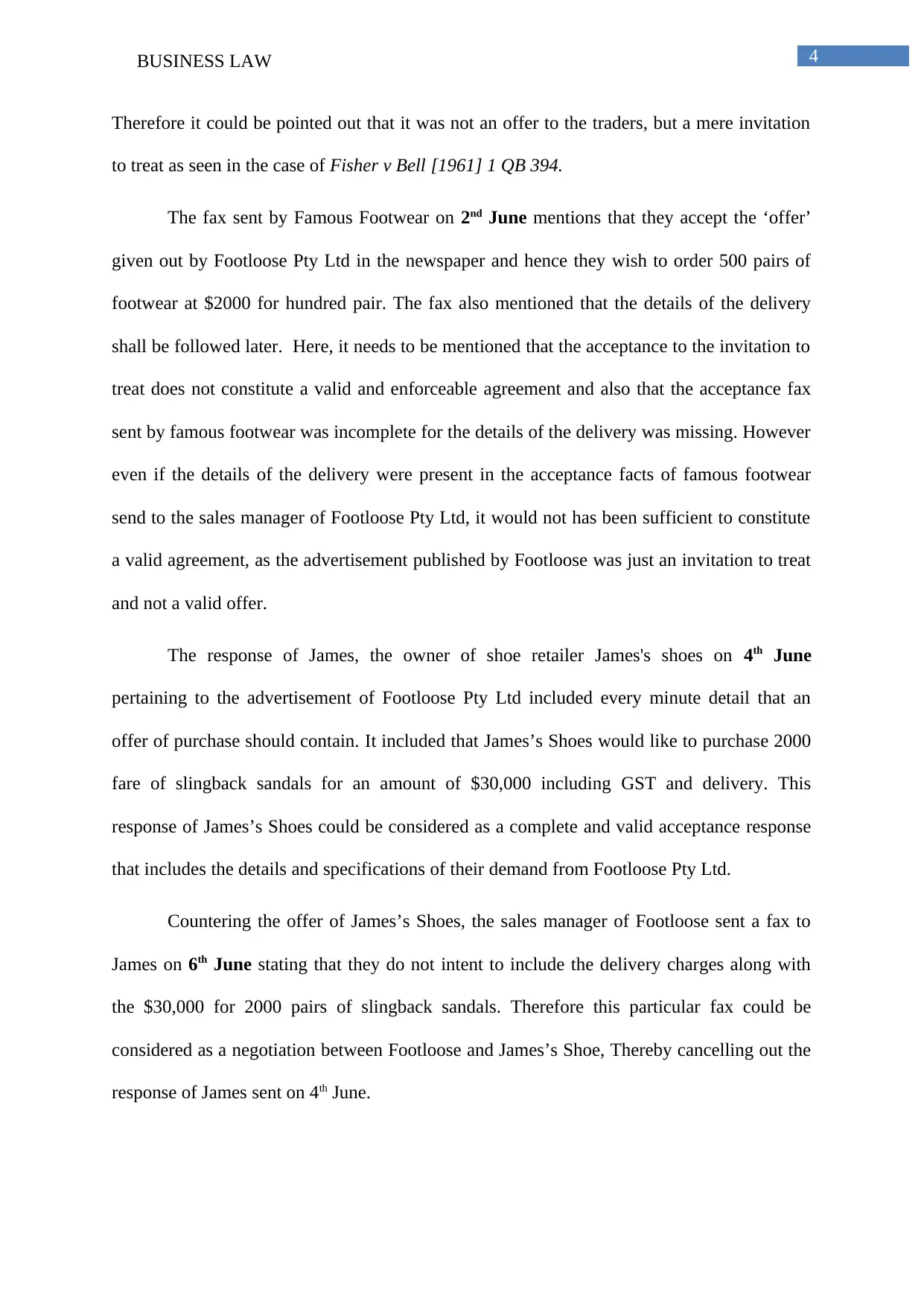
4BUSINESS LAW
Therefore it could be pointed out that it was not an offer to the traders, but a mere invitation
to treat as seen in the case of Fisher v Bell [1961] 1 QB 394.
The fax sent by Famous Footwear on 2nd June mentions that they accept the ‘offer’
given out by Footloose Pty Ltd in the newspaper and hence they wish to order 500 pairs of
footwear at $2000 for hundred pair. The fax also mentioned that the details of the delivery
shall be followed later. Here, it needs to be mentioned that the acceptance to the invitation to
treat does not constitute a valid and enforceable agreement and also that the acceptance fax
sent by famous footwear was incomplete for the details of the delivery was missing. However
even if the details of the delivery were present in the acceptance facts of famous footwear
send to the sales manager of Footloose Pty Ltd, it would not has been sufficient to constitute
a valid agreement, as the advertisement published by Footloose was just an invitation to treat
and not a valid offer.
The response of James, the owner of shoe retailer James's shoes on 4th June
pertaining to the advertisement of Footloose Pty Ltd included every minute detail that an
offer of purchase should contain. It included that James’s Shoes would like to purchase 2000
fare of slingback sandals for an amount of $30,000 including GST and delivery. This
response of James’s Shoes could be considered as a complete and valid acceptance response
that includes the details and specifications of their demand from Footloose Pty Ltd.
Countering the offer of James’s Shoes, the sales manager of Footloose sent a fax to
James on 6th June stating that they do not intent to include the delivery charges along with
the $30,000 for 2000 pairs of slingback sandals. Therefore this particular fax could be
considered as a negotiation between Footloose and James’s Shoe, Thereby cancelling out the
response of James sent on 4th June.
Therefore it could be pointed out that it was not an offer to the traders, but a mere invitation
to treat as seen in the case of Fisher v Bell [1961] 1 QB 394.
The fax sent by Famous Footwear on 2nd June mentions that they accept the ‘offer’
given out by Footloose Pty Ltd in the newspaper and hence they wish to order 500 pairs of
footwear at $2000 for hundred pair. The fax also mentioned that the details of the delivery
shall be followed later. Here, it needs to be mentioned that the acceptance to the invitation to
treat does not constitute a valid and enforceable agreement and also that the acceptance fax
sent by famous footwear was incomplete for the details of the delivery was missing. However
even if the details of the delivery were present in the acceptance facts of famous footwear
send to the sales manager of Footloose Pty Ltd, it would not has been sufficient to constitute
a valid agreement, as the advertisement published by Footloose was just an invitation to treat
and not a valid offer.
The response of James, the owner of shoe retailer James's shoes on 4th June
pertaining to the advertisement of Footloose Pty Ltd included every minute detail that an
offer of purchase should contain. It included that James’s Shoes would like to purchase 2000
fare of slingback sandals for an amount of $30,000 including GST and delivery. This
response of James’s Shoes could be considered as a complete and valid acceptance response
that includes the details and specifications of their demand from Footloose Pty Ltd.
Countering the offer of James’s Shoes, the sales manager of Footloose sent a fax to
James on 6th June stating that they do not intent to include the delivery charges along with
the $30,000 for 2000 pairs of slingback sandals. Therefore this particular fax could be
considered as a negotiation between Footloose and James’s Shoe, Thereby cancelling out the
response of James sent on 4th June.
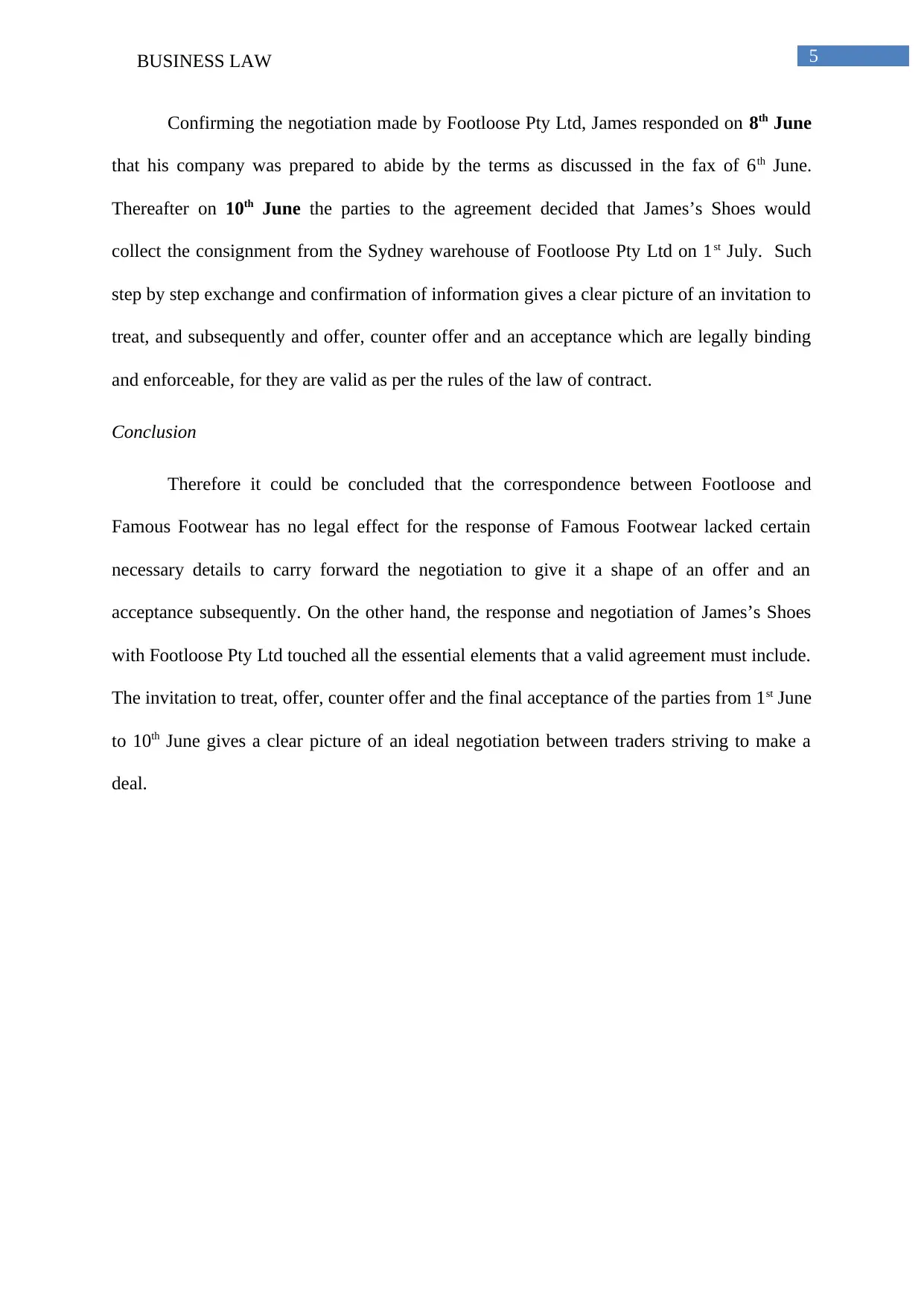
5BUSINESS LAW
Confirming the negotiation made by Footloose Pty Ltd, James responded on 8th June
that his company was prepared to abide by the terms as discussed in the fax of 6th June.
Thereafter on 10th June the parties to the agreement decided that James’s Shoes would
collect the consignment from the Sydney warehouse of Footloose Pty Ltd on 1st July. Such
step by step exchange and confirmation of information gives a clear picture of an invitation to
treat, and subsequently and offer, counter offer and an acceptance which are legally binding
and enforceable, for they are valid as per the rules of the law of contract.
Conclusion
Therefore it could be concluded that the correspondence between Footloose and
Famous Footwear has no legal effect for the response of Famous Footwear lacked certain
necessary details to carry forward the negotiation to give it a shape of an offer and an
acceptance subsequently. On the other hand, the response and negotiation of James’s Shoes
with Footloose Pty Ltd touched all the essential elements that a valid agreement must include.
The invitation to treat, offer, counter offer and the final acceptance of the parties from 1st June
to 10th June gives a clear picture of an ideal negotiation between traders striving to make a
deal.
Confirming the negotiation made by Footloose Pty Ltd, James responded on 8th June
that his company was prepared to abide by the terms as discussed in the fax of 6th June.
Thereafter on 10th June the parties to the agreement decided that James’s Shoes would
collect the consignment from the Sydney warehouse of Footloose Pty Ltd on 1st July. Such
step by step exchange and confirmation of information gives a clear picture of an invitation to
treat, and subsequently and offer, counter offer and an acceptance which are legally binding
and enforceable, for they are valid as per the rules of the law of contract.
Conclusion
Therefore it could be concluded that the correspondence between Footloose and
Famous Footwear has no legal effect for the response of Famous Footwear lacked certain
necessary details to carry forward the negotiation to give it a shape of an offer and an
acceptance subsequently. On the other hand, the response and negotiation of James’s Shoes
with Footloose Pty Ltd touched all the essential elements that a valid agreement must include.
The invitation to treat, offer, counter offer and the final acceptance of the parties from 1st June
to 10th June gives a clear picture of an ideal negotiation between traders striving to make a
deal.
⊘ This is a preview!⊘
Do you want full access?
Subscribe today to unlock all pages.

Trusted by 1+ million students worldwide
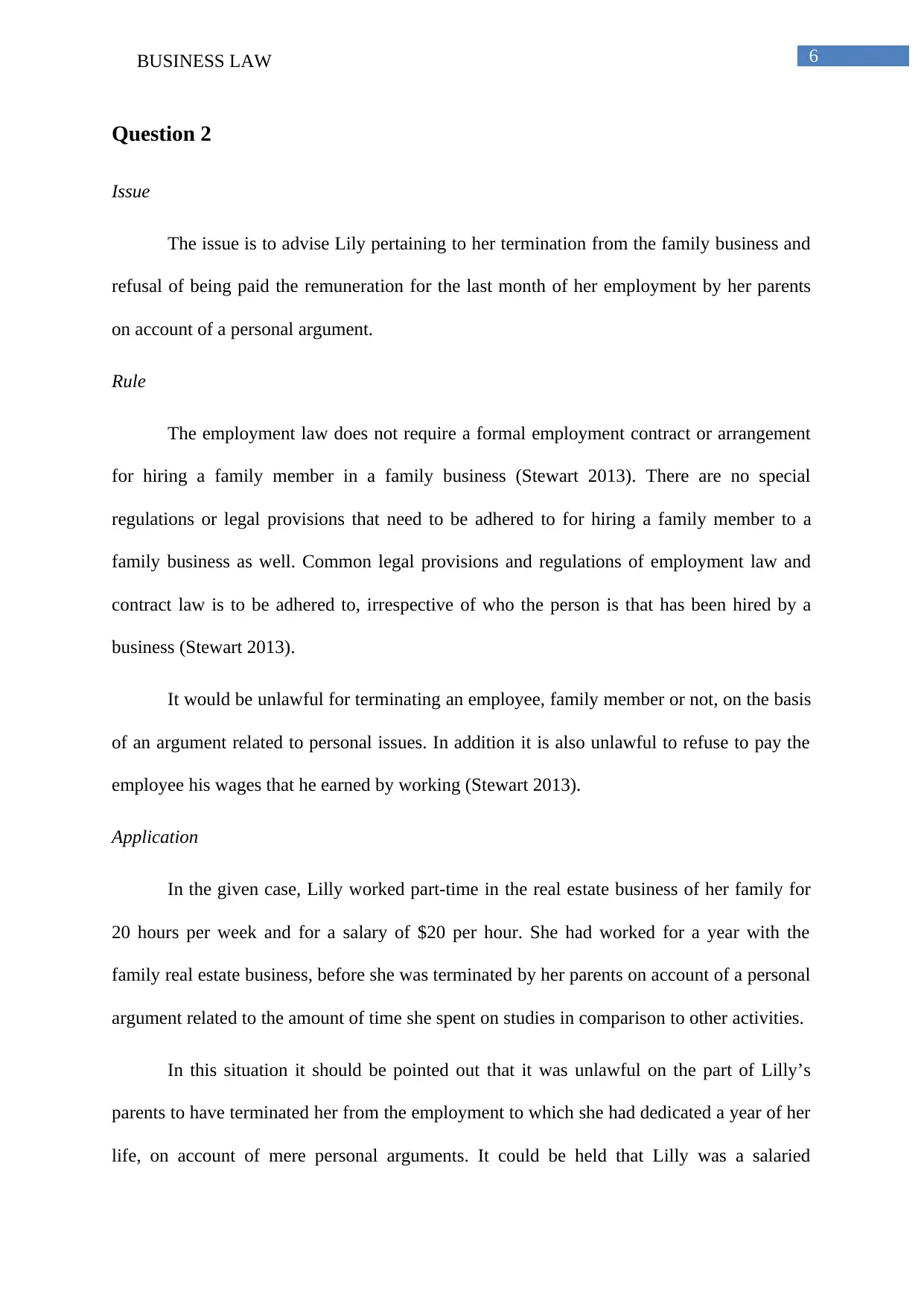
6BUSINESS LAW
Question 2
Issue
The issue is to advise Lily pertaining to her termination from the family business and
refusal of being paid the remuneration for the last month of her employment by her parents
on account of a personal argument.
Rule
The employment law does not require a formal employment contract or arrangement
for hiring a family member in a family business (Stewart 2013). There are no special
regulations or legal provisions that need to be adhered to for hiring a family member to a
family business as well. Common legal provisions and regulations of employment law and
contract law is to be adhered to, irrespective of who the person is that has been hired by a
business (Stewart 2013).
It would be unlawful for terminating an employee, family member or not, on the basis
of an argument related to personal issues. In addition it is also unlawful to refuse to pay the
employee his wages that he earned by working (Stewart 2013).
Application
In the given case, Lilly worked part-time in the real estate business of her family for
20 hours per week and for a salary of $20 per hour. She had worked for a year with the
family real estate business, before she was terminated by her parents on account of a personal
argument related to the amount of time she spent on studies in comparison to other activities.
In this situation it should be pointed out that it was unlawful on the part of Lilly’s
parents to have terminated her from the employment to which she had dedicated a year of her
life, on account of mere personal arguments. It could be held that Lilly was a salaried
Question 2
Issue
The issue is to advise Lily pertaining to her termination from the family business and
refusal of being paid the remuneration for the last month of her employment by her parents
on account of a personal argument.
Rule
The employment law does not require a formal employment contract or arrangement
for hiring a family member in a family business (Stewart 2013). There are no special
regulations or legal provisions that need to be adhered to for hiring a family member to a
family business as well. Common legal provisions and regulations of employment law and
contract law is to be adhered to, irrespective of who the person is that has been hired by a
business (Stewart 2013).
It would be unlawful for terminating an employee, family member or not, on the basis
of an argument related to personal issues. In addition it is also unlawful to refuse to pay the
employee his wages that he earned by working (Stewart 2013).
Application
In the given case, Lilly worked part-time in the real estate business of her family for
20 hours per week and for a salary of $20 per hour. She had worked for a year with the
family real estate business, before she was terminated by her parents on account of a personal
argument related to the amount of time she spent on studies in comparison to other activities.
In this situation it should be pointed out that it was unlawful on the part of Lilly’s
parents to have terminated her from the employment to which she had dedicated a year of her
life, on account of mere personal arguments. It could be held that Lilly was a salaried
Paraphrase This Document
Need a fresh take? Get an instant paraphrase of this document with our AI Paraphraser
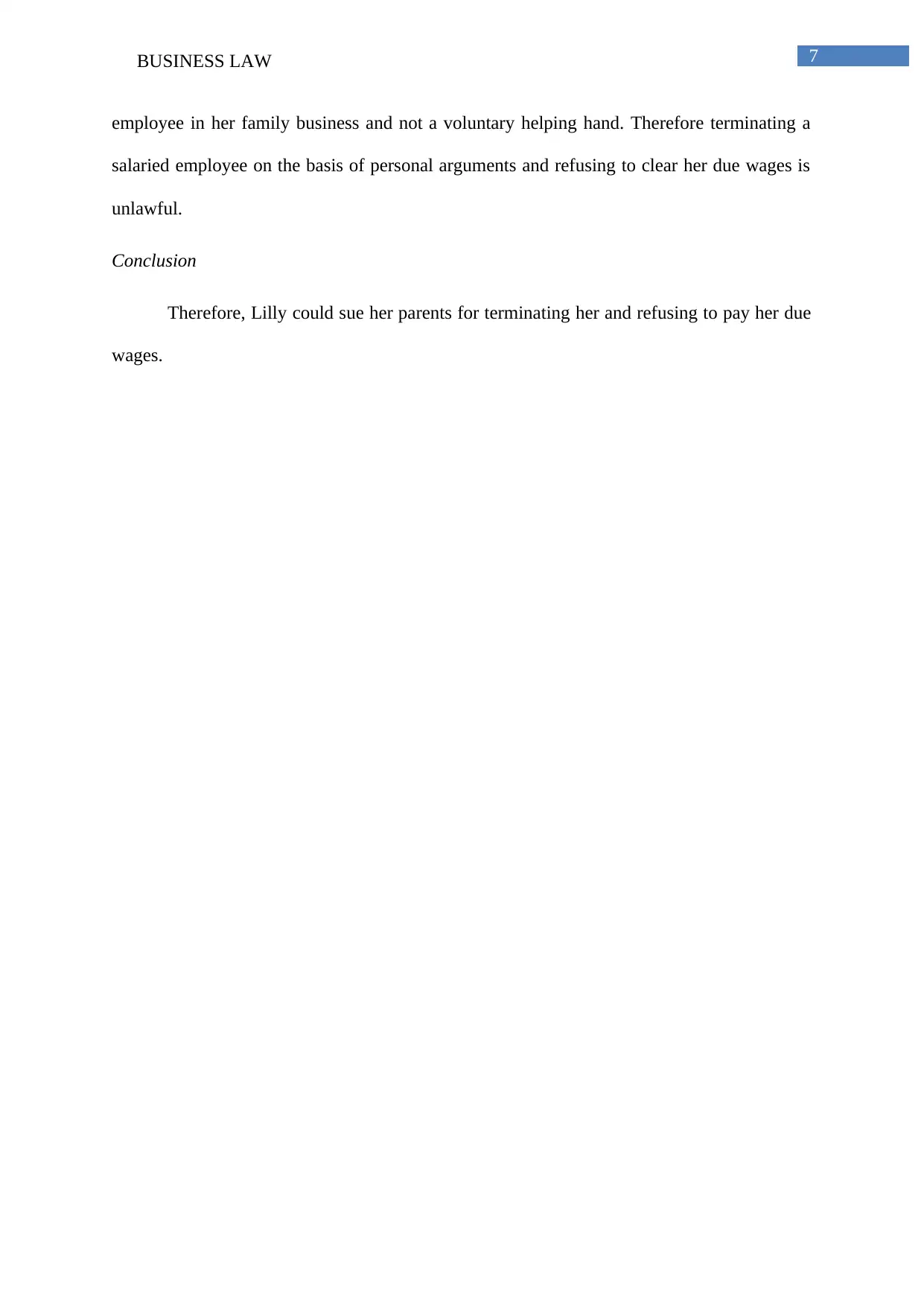
7BUSINESS LAW
employee in her family business and not a voluntary helping hand. Therefore terminating a
salaried employee on the basis of personal arguments and refusing to clear her due wages is
unlawful.
Conclusion
Therefore, Lilly could sue her parents for terminating her and refusing to pay her due
wages.
employee in her family business and not a voluntary helping hand. Therefore terminating a
salaried employee on the basis of personal arguments and refusing to clear her due wages is
unlawful.
Conclusion
Therefore, Lilly could sue her parents for terminating her and refusing to pay her due
wages.
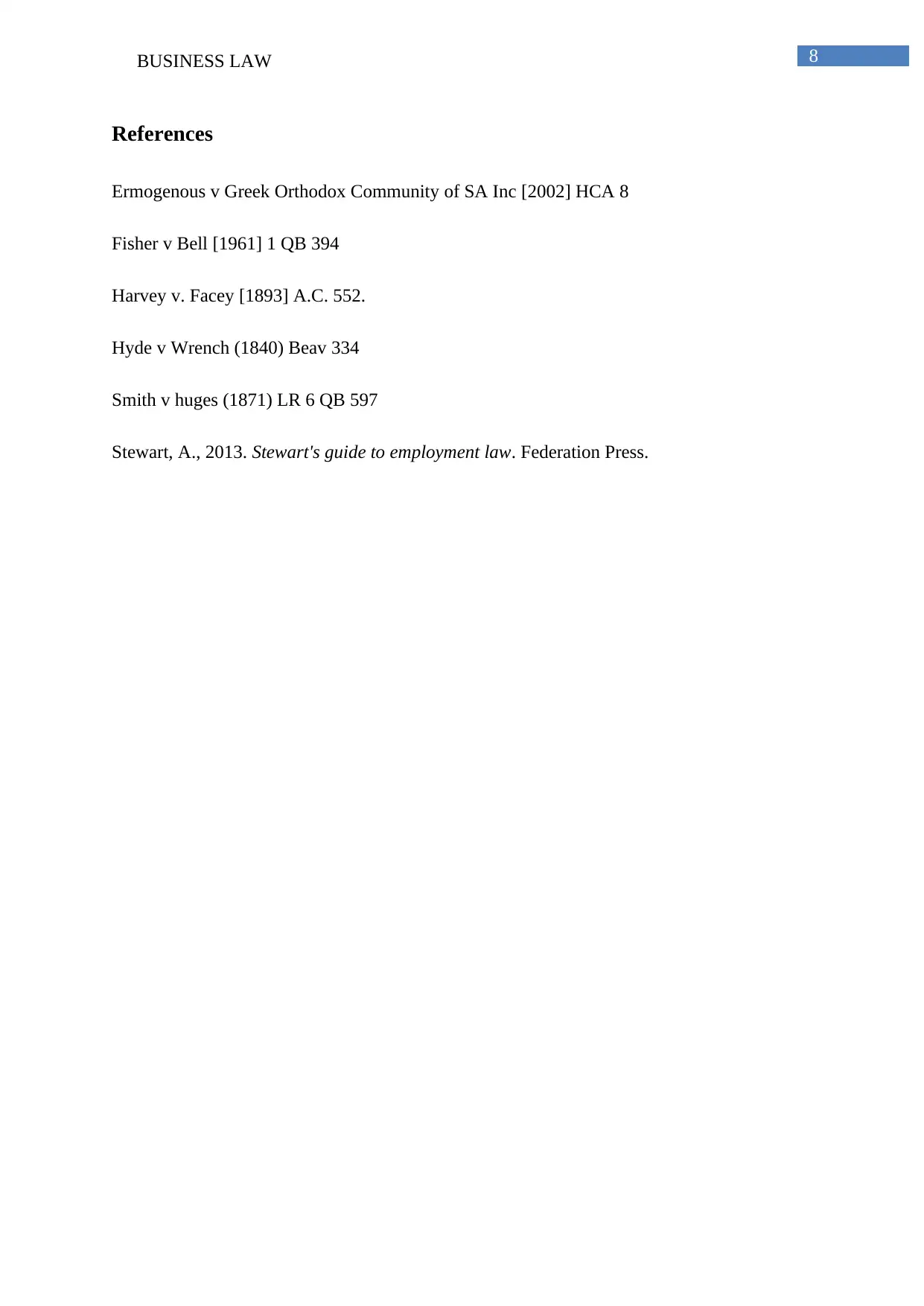
8BUSINESS LAW
References
Ermogenous v Greek Orthodox Community of SA Inc [2002] HCA 8
Fisher v Bell [1961] 1 QB 394
Harvey v. Facey [1893] A.C. 552.
Hyde v Wrench (1840) Beav 334
Smith v huges (1871) LR 6 QB 597
Stewart, A., 2013. Stewart's guide to employment law. Federation Press.
References
Ermogenous v Greek Orthodox Community of SA Inc [2002] HCA 8
Fisher v Bell [1961] 1 QB 394
Harvey v. Facey [1893] A.C. 552.
Hyde v Wrench (1840) Beav 334
Smith v huges (1871) LR 6 QB 597
Stewart, A., 2013. Stewart's guide to employment law. Federation Press.
⊘ This is a preview!⊘
Do you want full access?
Subscribe today to unlock all pages.

Trusted by 1+ million students worldwide
1 out of 9
Related Documents
Your All-in-One AI-Powered Toolkit for Academic Success.
+13062052269
info@desklib.com
Available 24*7 on WhatsApp / Email
![[object Object]](/_next/static/media/star-bottom.7253800d.svg)
Unlock your academic potential
Copyright © 2020–2025 A2Z Services. All Rights Reserved. Developed and managed by ZUCOL.




